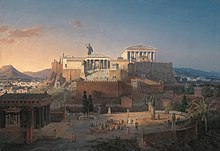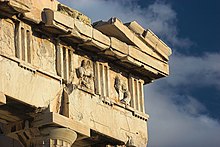The
Parthenon (
Ancient Greek:
Παρθενών) is a
temple on the
Athenian Acropolis, Greece, dedicated to the
Greek goddess Athena, whom the people of Athens considered their patron. Its construction began in 447 BC and was completed in 438 BC, although decorations of the Parthenon continued until 432 BC. It is the most important surviving building of
Classical Greece, generally considered to be the culmination of the development of the
Doric order. Its decorative sculptures are considered some of the high points of
Greek art. The Parthenon is regarded as an enduring symbol of
Ancient Greece and of
Athenian democracy and one of the world's greatest cultural monuments. The
Greek Ministry of Culture is currently carrying out a program of selective restoration and reconstruction to ensure the stability of the partially ruined structure.
[3]The Parthenon itself replaced an older temple of Athena, which historians call the Pre-Parthenon or
Older Parthenon, that was destroyed in the
Persian invasion of 480 BC. Like most Greek temples, the Parthenon was used as a
treasury. For a time, it served as the treasury of the
Delian League, which later became the Athenian Empire. In the 5th century AD, the Parthenon was converted into a
Christian church dedicated to the
Virgin Mary. After the
Ottoman Turk conquest, it was turned into a mosque in the early 1460s, and it had a
minaret built in it. On 26 September 1687, an Ottoman Turk ammunition dump inside the building was ignited by
Venetianbombardment. The resulting explosion severely damaged the Parthenon and its sculptures. In 1806,
Thomas Bruce, 7th Earl of Elginremoved some of the surviving sculptures, with the Ottoman Turks' permission. These sculptures, now known as the
Elgin Marbles or the Parthenon Marbles, were sold in 1816 to the
British Museum in London, where they are now displayed. The Greek government is committed to the return of the sculptures to Greece, so far with no success.
[4]Etymology
The origin of the Parthenon's name is from the
Greek word "παρθενών" (
parthenon), which referred to the "
virgin's apartments" in a house and in the Parthenon's case seems to have been used only for a particular room of the temple;
[5] it is debated which room this is and how the room acquired its name. The
Liddell-Scott-Jones Greek-English Lexicon states that this room was the western
cella of the Parthenon. Jamauri D. Green holds that the parthenon was the room in which the
peplos presented to Athena at the
Panathenaic Festival was woven by the
arrephoroi, a group of four young girls chosen to serve Athena each year.
[6] Christopher Pelling asserts that Athena Parthenos may have constituted a discrete cult of Athena, intimately connected with, but not identical to, that of
Athena Polias.
[7] According to this theory, the name of Parthenon means the "temple of the virgin goddess" and refers to the cult of Athena Parthenos that was associated with the temple.
[8] The epithet
parthénos (
Greek:
παρθένος), whose origin is also unclear,
[9] meant "maiden, girl", but also "virgin, unmarried woman"
[10] and was especially used for
Artemis, the goddess of wild animals, the hunt, and vegetation, and for Athena, the goddess of strategy and tactics, handicraft, and practical reason.
[11] It has also been suggested that the name of the temple alludes to the virgins (
parthenoi), whose supreme sacrifice guaranteed the safety of the city.
Architecture

Floor plan of the Parthenon

Reconstruction of the Acropolis and Areus Pagus in Athens,
Leo von Klenze, 1846
The first endeavor to build a sanctuary for
Athena Parthenos on the site of the present Parthenon was begun shortly after the
Battle of Marathon (c. 490–488 BC) upon a muscular
limestone foundation that extended and leveled the southern part of the Acropolis summit. This building was replaced by a hekatompedon (meaning "hundred-footer") and would have stood beside the archaic temple dedicated to the Athena Polias. The
Older or Pre-Parthenon, as it is frequently referred to, was still under construction when the
Persians sacked the city in 480 BC and razed the Acropolis.
[15][16]In the mid-5th century BC, when the Athenian Acropolis became the seat of the
Delian League and Athens was the greatest cultural centre of its time,
Pericles initiated an ambitious building project that lasted the entire second half of the century. The most important buildings visible on the Acropolis today—the Parthenon, the Propylaia, the Erechtheion and the temple of Athena Nike—were erected during this period. The Parthenon was built under the general supervision of the sculptor
Phidias, who also had charge of the sculptural decoration. The architects,
Iktinos and
Kallikrates, began in 447 BC, and the building was substantially completed by 432, but work on the decorations continued until at least 431. Some of the financial accounts for the Parthenon survive and show that the largest single expense was transporting the stone from
Mount Pentelicus, about 16 kilometres from Athens, to the Acropolis. The funds were partly drawn from the treasury of the Delian League, which was moved from the Panhellenic sanctuary at
Delos to the Acropolis in 454 BC.
Although the nearby
Temple of Hephaestus is the most complete surviving example of a
Doric order temple, the Parthenon, in its day, was regarded as the finest. The temple, wrote
John Julius Cooper, "Enjoys the reputation of being the most perfect
Doric temple ever built. Even in antiquity, its architectural refinements were legendary, especially the subtle correspondence between the curvature of the
stylobate, the taper of the
naos walls and the
entasis of the columns."
[17] Entasis refers to the slight bulge of the columns as they rise, though the observable effect on the Parthenon is considerably more subtle than on earlier temples with their noticeably cigar-shaped columns. The stylobate is the platform on which the columns stand. As in many other classical Greek temples,
[18] it has a slight parabolic upward curvature intended to shed rainwater and reinforce the building against earthquakes. The columns might therefore be supposed to lean outwards, but they actually lean slightly inwards so that if they carried on, they would meet exactly a mile above the centre of the Parthenon; since they are all the same height, the curvature of the outer stylobate edge is transmitted to the
architrave and roof above: "All follow the rule of being built to delicate curves," Gorham Stevens observed when pointing out that, in addition, the west front was built at a slightly higher level than that of the east front.
[19] It is not universally agreed what the intended effect of these "optical refinements" was; it may serve as a sort of "reverse optical illusion".
[20] As the Greeks may have been aware, two parallel lines appear to bow, or curve outward, when intersected by converging lines. In this case, the ceiling and floor of the temple may seem to bow in the presence of the surrounding angles of the building. Striving for perfection, the designers may have added these curves, compensating for the illusion by creating their own curves, thus negating this effect and allowing the temple to be seen as they intended. It is also suggested that it was to enliven what might have appeared an inert mass in the case of a building without curves, but the comparison ought to be with the Parthenon's more obviously curved predecessors than with a notional rectilinear temple.
Some studies of the Acropolis, including the Parthenon, conclude that many of its proportions approximate the
golden ratio. The Parthenon's facade as well as elements of its facade and elsewhere can be circumscribed by
golden rectangles.
[21] This view that the golden ratio was employed in the design has been disputed in more recent studies.
[22]Measured at the stylobate, the dimensions of the base of the Parthenon are 69.5 metres by 30.9 metres (228.0 x 101.4 ft). The
cella was 29.8 metres long by 19.2 metres wide (97.8 x 63.0 ft), with internal colonnades in two tiers, structurally necessary to support the roof. On the exterior, the Doric columns measure 1.9 metres (6.2 ft) in diameter and are 10.4 metres (34.1 ft) high. The corner columns are slightly larger in diameter. The Parthenon had 46 outer pillars and 23 inner pillars in total. The stylobate has an upward curvature towards its centre of 60 millimetres (2.36 in) on the east and west ends, and of 110 millimetres (4.33 in) on the sides. The roof was covered with large overlapping marble tiles known as
imbrices and tegulae.
[edit]Sculpture

The Parthenon from the south. In the foreground of the image, a reconstruction of the marble
imbrices and tegulae (roof tiles) forming the roof is visible, resting on wooden supports.
The Parthenon, an
octostyle,
peripteral Doric temple with
Ionic architectural features, housed the
chryselephantine statue of
Athena Parthenossculpted by
Phidias and dedicated in 439 or 438 BC. The decorative stonework was originally highly coloured.
[23] The temple was dedicated to Athena at that time, though construction continued until almost the beginning of the
Peloponnesian War in 432. By the year 438, the sculptural decoration of the Doric metopes on the frieze above the exterior colonnade, and of the Ionic frieze around the upper portion of the walls of the
cella, had been completed. The richness of the Parthenon's frieze and metope decoration is in agreement with the function of the temple as a treasury. In the
opisthodomus (the back room of the cella) were stored the monetary contributions of the Delian League, of which Athens was the leading member.
[edit]Metopes

Detail of the West metopes, illustrating the current condition of the temple in detail after 2,500 years of war, pollution, erratic conservation, pillage and vandalism
The ninety-two
metopes were carved in high relief, a practice employed until then only in treasuries (buildings used to keep votive gifts to the gods). According to the building records, the
metopesculptures date to the years 446–440 BC. Their design is attributed to the sculptor Kalamis. The metopes of the east side of the Parthenon, above the main entrance, depict the
Gigantomachy(mythical battles between the Olympian gods and the
Giants). The metopes of the west end show
Amazonomachy (mythical battle of the Athenians against the
Amazons). The metopes of the south side show the Thessalian
Centauromachy (battle of the
Lapiths aided by
Theseus against the half-man, half-horse
Centaurs). Metopes 13–21 are missing, but drawings from 1674 attributed to Jaques Carrey indicate a series of humans; these have been interpreted as scenes from the
Lapith wedding, scenes from the early history of Athens and various myths.
[24] On the north side of the Parthenon, the metopes are poorly preserved, but the subject seems to be the
sack of Troy.
The metopes present surviving traces of the
Severe Style in the anatomy of the figures' heads, in the limitation of the corporal movements to the contours and not to the muscles, and in the presence of pronounced veins in the figures of the
Centauromachy. Several of the metopes still remain on the building, but, with the exception of those on the northern side, they are severely damaged. Some of them are located at the
Acropolis Museum, others are in the British Museum, and one can be seen at the
Louvre museum.













